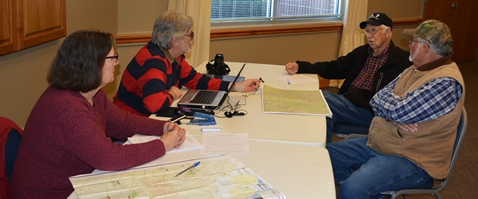Civil War stories collected

PRESCOTT – Joseph and Maria Brent, with Mudpuppy and Waterdog, Inc., were at the Nevada County Library Friday collecting Civil War stories.
Joseph is a historian, while Maria is a certified interpretive planner. The two collected stories connected to the Civil War battles fought in Nevada County and will use the information on an interpretive plan for the Nevada County Depot Museum concerning the Camden Expedition pf 1864.
Three battles were fought in Nevada County in April 1864. The first was at Elkins Ferry, followed by Prairie D’Ane and ending at Moscow. The two said they are looking for stories about how the citizenry was affected by the troops from both sides being here. They agreed there isn’t much need for stories from the military side as there are reports, letters and other information about that.
Overall, the goal is to develop the three Civil War sites for heritage tourism. Heritage tourists tend to stay in areas longer and spend more money, thereby helping the local economy. Maria said they look at two areas for this – local awareness and how to attract visitors to the county. The plan will include information such as driving tours and walking trails of the three sites.
Currently, the museum is working to acquire around 180 acres of the Prairie D’Ane battlefield. According to Paul Ridgell, a member of the museum’s board of directors, the museum still needs around $90,000 to complete the purchase, and is seeking donations. Eventually, the goal is to build a visitor’s center, possibly with a gift shop, for tourists, and educate visitors about the history that took place in Nevada County, while providing a boost in the area of economic development.
Maria said they are looking for family histories to incorporate into the interpretive plan, which will be turned over to the museum when completed. The problem, she said, is most of the civilian history wasn’t written down, but was passed on via word of mouth from generation to generation.
Joe said the interpretive planning came about from a meeting last fall where people suggested it would be useful to collect family stories of the period. However, he added, getting this information isn’t easy, but the goal is to find out how citizens interacted with soldiers from both sides and what happened to the families involved.
He pointed out the Union soldiers were without food, adding he’s sure there were some unpleasant experiences by the local residents as their livestock and chickens were confiscated to feed the enemy army. As the battles occurred in April, he said, the gardens hadn’t produced anything yet. Regardless, families were left with little or no food themselves once the Union troops went through.
“We’re trying to bring this to the human level,” he said. “When taking food and livestock from people, there are problems because it’s still people being people.”
Jay Trevillion and John L. McWilliams were the first two local residents to share stories with the Brents. They talked about where the original ford was where Union troops crossed the Little Missouri River and how the troops moved along section lines.
Maria said the first draft of the interpretive plan should be finished by April. Copies of this will be available for people to look at and check for mistakes. The final copy will be ready by June.



